Miao Yin
AdaCM$^2$: On Understanding Extremely Long-Term Video with Adaptive Cross-Modality Memory Reduction
Nov 19, 2024Abstract:The advancements in large language models (LLMs) have propelled the improvement of video understanding tasks by incorporating LLMs with visual models. However, most existing LLM-based models (e.g., VideoLLaMA, VideoChat) are constrained to processing short-duration videos. Recent attempts to understand long-term videos by extracting and compressing visual features into a fixed memory size. Nevertheless, those methods leverage only visual modality to merge video tokens and overlook the correlation between visual and textual queries, leading to difficulties in effectively handling complex question-answering tasks. To address the challenges of long videos and complex prompts, we propose AdaCM$^2$, which, for the first time, introduces an adaptive cross-modality memory reduction approach to video-text alignment in an auto-regressive manner on video streams. Our extensive experiments on various video understanding tasks, such as video captioning, video question answering, and video classification, demonstrate that AdaCM$^2$ achieves state-of-the-art performance across multiple datasets while significantly reducing memory usage. Notably, it achieves a 4.5% improvement across multiple tasks in the LVU dataset with a GPU memory consumption reduction of up to 65%.
GaussianSpa: An "Optimizing-Sparsifying" Simplification Framework for Compact and High-Quality 3D Gaussian Splatting
Nov 09, 2024



Abstract:3D Gaussian Splatting (3DGS) has emerged as a mainstream for novel view synthesis, leveraging continuous aggregations of Gaussian functions to model scene geometry. However, 3DGS suffers from substantial memory requirements to store the multitude of Gaussians, hindering its practicality. To address this challenge, we introduce GaussianSpa, an optimization-based simplification framework for compact and high-quality 3DGS. Specifically, we formulate the simplification as an optimization problem associated with the 3DGS training. Correspondingly, we propose an efficient "optimizing-sparsifying" solution that alternately solves two independent sub-problems, gradually imposing strong sparsity onto the Gaussians in the training process. Our comprehensive evaluations on various datasets show the superiority of GaussianSpa over existing state-of-the-art approaches. Notably, GaussianSpa achieves an average PSNR improvement of 0.9 dB on the real-world Deep Blending dataset with 10$\times$ fewer Gaussians compared to the vanilla 3DGS. Our project page is available at https://gaussianspa.github.io/.
MoE-I$^2$: Compressing Mixture of Experts Models through Inter-Expert Pruning and Intra-Expert Low-Rank Decomposition
Nov 01, 2024

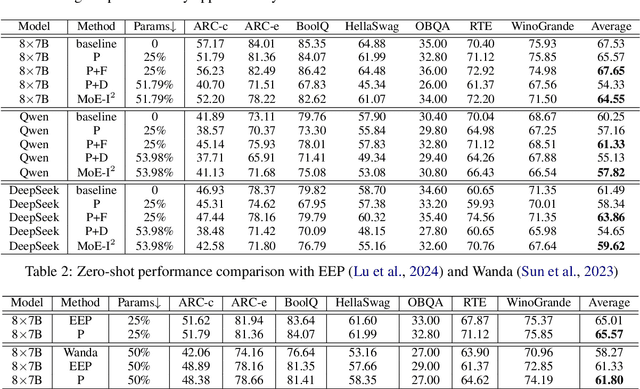
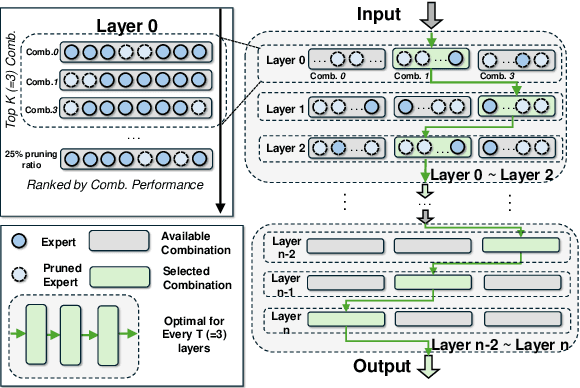
Abstract:The emergence of Mixture of Experts (MoE) LLMs has significantly advanced the development of language models. Compared to traditional LLMs, MoE LLMs outperform traditional LLMs by achieving higher performance with considerably fewer activated parameters. Despite this efficiency, their enormous parameter size still leads to high deployment costs. In this paper, we introduce a two-stage compression method tailored for MoE to reduce the model size and decrease the computational cost. First, in the inter-expert pruning stage, we analyze the importance of each layer and propose the Layer-wise Genetic Search and Block-wise KT-Reception Field with the non-uniform pruning ratio to prune the individual expert. Second, in the intra-expert decomposition stage, we apply the low-rank decomposition to further compress the parameters within the remaining experts. Extensive experiments on Qwen1.5-MoE-A2.7B, DeepSeek-V2-Lite, and Mixtral-8$\times$7B demonstrate that our proposed methods can both reduce the model size and enhance inference efficiency while maintaining performance in various zero-shot tasks. The code will be available at \url{https://github.com/xiaochengsky/MoEI-2.git}
Enhancing Lossy Compression Through Cross-Field Information for Scientific Applications
Sep 26, 2024



Abstract:Lossy compression is one of the most effective methods for reducing the size of scientific data containing multiple data fields. It reduces information density through prediction or transformation techniques to compress the data. Previous approaches use local information from a single target field when predicting target data points, limiting their potential to achieve higher compression ratios. In this paper, we identified significant cross-field correlations within scientific datasets. We propose a novel hybrid prediction model that utilizes CNN to extract cross-field information and combine it with existing local field information. Our solution enhances the prediction accuracy of lossy compressors, leading to improved compression ratios without compromising data quality. We evaluate our solution on three scientific datasets, demonstrating its ability to improve compression ratios by up to 25% under specific error bounds. Additionally, our solution preserves more data details and reduces artifacts compared to baseline approaches.
NeurLZ: On Enhancing Lossy Compression Performance based on Error-Controlled Neural Learning for Scientific Data
Sep 10, 2024Abstract:Large-scale scientific simulations generate massive datasets that pose significant challenges for storage and I/O. While traditional lossy compression techniques can improve performance, balancing compression ratio, data quality, and throughput remains difficult. To address this, we propose NeurLZ, a novel cross-field learning-based and error-controlled compression framework for scientific data. By integrating skipping DNN models, cross-field learning, and error control, our framework aims to substantially enhance lossy compression performance. Our contributions are three-fold: (1) We design a lightweight skipping model to provide high-fidelity detail retention, further improving prediction accuracy. (2) We adopt a cross-field learning approach to significantly improve data prediction accuracy, resulting in a substantially improved compression ratio. (3) We develop an error control approach to provide strict error bounds according to user requirements. We evaluated NeurLZ on several real-world HPC application datasets, including Nyx (cosmological simulation), Miranda (large turbulence simulation), and Hurricane (weather simulation). Experiments demonstrate that our framework achieves up to a 90% relative reduction in bit rate under the same data distortion, compared to the best existing approach.
SmartMem: Layout Transformation Elimination and Adaptation for Efficient DNN Execution on Mobile
Apr 21, 2024



Abstract:This work is motivated by recent developments in Deep Neural Networks, particularly the Transformer architectures underlying applications such as ChatGPT, and the need for performing inference on mobile devices. Focusing on emerging transformers (specifically the ones with computationally efficient Swin-like architectures) and large models (e.g., Stable Diffusion and LLMs) based on transformers, we observe that layout transformations between the computational operators cause a significant slowdown in these applications. This paper presents SmartMem, a comprehensive framework for eliminating most layout transformations, with the idea that multiple operators can use the same tensor layout through careful choice of layout and implementation of operations. Our approach is based on classifying the operators into four groups, and considering combinations of producer-consumer edges between the operators. We develop a set of methods for searching such layouts. Another component of our work is developing efficient memory layouts for 2.5 dimensional memory commonly seen in mobile devices. Our experimental results show that SmartMem outperforms 5 state-of-the-art DNN execution frameworks on mobile devices across 18 varied neural networks, including CNNs, Transformers with both local and global attention, as well as LLMs. In particular, compared to DNNFusion, SmartMem achieves an average speedup of 2.8$\times$, and outperforms TVM and MNN with speedups of 6.9$\times$ and 7.9$\times$, respectively, on average.
GWLZ: A Group-wise Learning-based Lossy Compression Framework for Scientific Data
Apr 20, 2024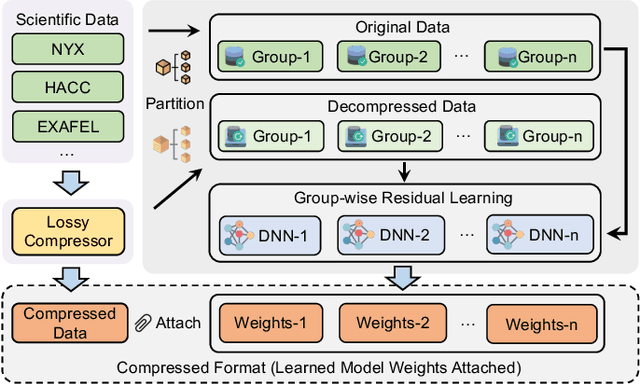

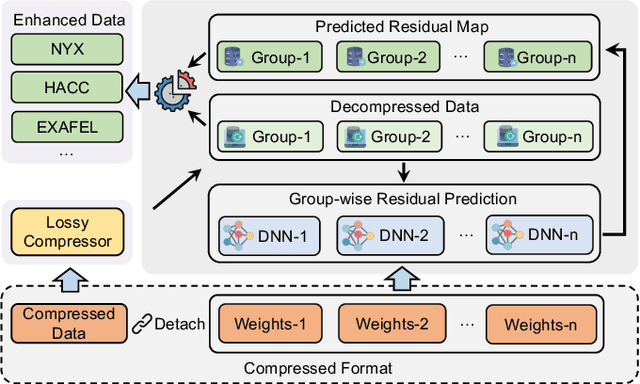
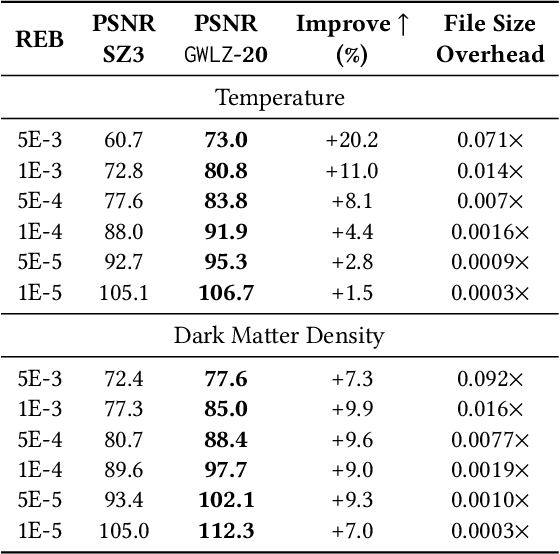
Abstract:The rapid expansion of computational capabilities and the ever-growing scale of modern HPC systems present formidable challenges in managing exascale scientific data. Faced with such vast datasets, traditional lossless compression techniques prove insufficient in reducing data size to a manageable level while preserving all information intact. In response, researchers have turned to error-bounded lossy compression methods, which offer a balance between data size reduction and information retention. However, despite their utility, these compressors employing conventional techniques struggle with limited reconstruction quality. To address this issue, we draw inspiration from recent advancements in deep learning and propose GWLZ, a novel group-wise learning-based lossy compression framework with multiple lightweight learnable enhancer models. Leveraging a group of neural networks, GWLZ significantly enhances the decompressed data reconstruction quality with negligible impact on the compression efficiency. Experimental results on different fields from the Nyx dataset demonstrate remarkable improvements by GWLZ, achieving up to 20% quality enhancements with negligible overhead as low as 0.0003x.
ELRT: Efficient Low-Rank Training for Compact Convolutional Neural Networks
Jan 18, 2024Abstract:Low-rank compression, a popular model compression technique that produces compact convolutional neural networks (CNNs) with low rankness, has been well-studied in the literature. On the other hand, low-rank training, as an alternative way to train low-rank CNNs from scratch, has been exploited little yet. Unlike low-rank compression, low-rank training does not need pre-trained full-rank models, and the entire training phase is always performed on the low-rank structure, bringing attractive benefits for practical applications. However, the existing low-rank training solutions still face several challenges, such as a considerable accuracy drop and/or still needing to update full-size models during the training. In this paper, we perform a systematic investigation on low-rank CNN training. By identifying the proper low-rank format and performance-improving strategy, we propose ELRT, an efficient low-rank training solution for high-accuracy, high-compactness, low-rank CNN models. Our extensive evaluation results for training various CNNs on different datasets demonstrate the effectiveness of ELRT.
COMCAT: Towards Efficient Compression and Customization of Attention-Based Vision Models
Jun 09, 2023



Abstract:Attention-based vision models, such as Vision Transformer (ViT) and its variants, have shown promising performance in various computer vision tasks. However, these emerging architectures suffer from large model sizes and high computational costs, calling for efficient model compression solutions. To date, pruning ViTs has been well studied, while other compression strategies that have been widely applied in CNN compression, e.g., model factorization, is little explored in the context of ViT compression. This paper explores an efficient method for compressing vision transformers to enrich the toolset for obtaining compact attention-based vision models. Based on the new insight on the multi-head attention layer, we develop a highly efficient ViT compression solution, which outperforms the state-of-the-art pruning methods. For compressing DeiT-small and DeiT-base models on ImageNet, our proposed approach can achieve 0.45% and 0.76% higher top-1 accuracy even with fewer parameters. Our finding can also be applied to improve the customization efficiency of text-to-image diffusion models, with much faster training (up to $2.6\times$ speedup) and lower extra storage cost (up to $1927.5\times$ reduction) than the existing works.
HALOC: Hardware-Aware Automatic Low-Rank Compression for Compact Neural Networks
Jan 20, 2023



Abstract:Low-rank compression is an important model compression strategy for obtaining compact neural network models. In general, because the rank values directly determine the model complexity and model accuracy, proper selection of layer-wise rank is very critical and desired. To date, though many low-rank compression approaches, either selecting the ranks in a manual or automatic way, have been proposed, they suffer from costly manual trials or unsatisfied compression performance. In addition, all of the existing works are not designed in a hardware-aware way, limiting the practical performance of the compressed models on real-world hardware platforms. To address these challenges, in this paper we propose HALOC, a hardware-aware automatic low-rank compression framework. By interpreting automatic rank selection from an architecture search perspective, we develop an end-to-end solution to determine the suitable layer-wise ranks in a differentiable and hardware-aware way. We further propose design principles and mitigation strategy to efficiently explore the rank space and reduce the potential interference problem. Experimental results on different datasets and hardware platforms demonstrate the effectiveness of our proposed approach. On CIFAR-10 dataset, HALOC enables 0.07% and 0.38% accuracy increase over the uncompressed ResNet-20 and VGG-16 models with 72.20% and 86.44% fewer FLOPs, respectively. On ImageNet dataset, HALOC achieves 0.9% higher top-1 accuracy than the original ResNet-18 model with 66.16% fewer FLOPs. HALOC also shows 0.66% higher top-1 accuracy increase than the state-of-the-art automatic low-rank compression solution with fewer computational and memory costs. In addition, HALOC demonstrates the practical speedups on different hardware platforms, verified by the measurement results on desktop GPU, embedded GPU and ASIC accelerator.
 Add to Chrome
Add to Chrome Add to Firefox
Add to Firefox Add to Edge
Add to Edge